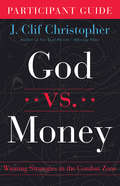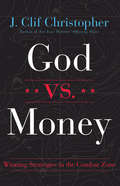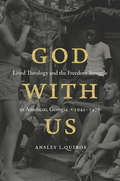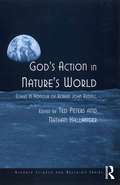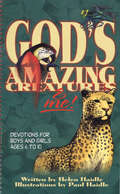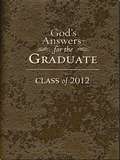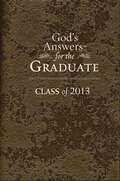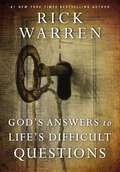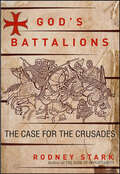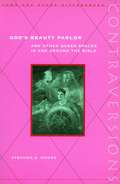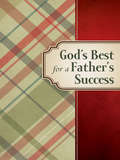- Table View
- List View
God vs. Money Participant Guide: Winning Strategies in the Combat Zone
by J. Clif ChristopherThe God vs. Money Participant Guide and DVD (ISBN 9781501891571) provide a process for applying key principles from the main book, God vs. Money (ISBN 9781501868115), in the participant’s own ministry context. This study is for leaders in churches and other ministry settings who have responsibility for capital campaigns, budgets, stewardship, planned giving, and other financial concerns. The typical study groups include finance committees, stewardship teams, foundation boards, and finance-related staff teams. The study is also recommended for continuing education of pastors and other church leaders. A copy of the main book (God vs. Money, ISBN 9781501868115) is required for each participant and a copy of the DVD (ISBN 9781501891571) is required for each group. Prior to each group session, participants should read a section of the book. Sessions start with a 7-10 minute video featuring Clif Christopher. Using the Guide, participants completes a variety of activities focused on application of key points from the prescribed reading. This may include discussion questions, personal reflection, group problem-solving activities, and other actions. The Guide serves as a workbook, giving each participant a place to record their thoughts and insights from the group, and to plan next steps.
God vs. Money: Winning Strategies in the Combat Zone
by J. Clif ChristopherGod and Money both make a lot of promises. God keeps all of God's promises, while Money keeps none. However, Money has better advertising, and we keep falling for it.Here's how to turn that trend around in your life and in the lives of those you lead.Chapters include:1. The Realities of the Situation2. The Preacher Must Be the Leader3. A Theology of Giving – Why We Do It4. Preach It5. Competing Is Not a Dirty Word6. Start Now and Don’t Quit7. You Have to Have a Budget8. Basic Fundraising Principles9. Making the Ask10. Big Money - Capital Campaigns11. Succeeding in a Capital Campaign12. Easy Money – Planned Giving13. Building, Banking and Bonds
God will do the Rest: 7 Keys to the Desires of Your Heart
by Catherine Galasso-Vigorito'The Key to the Kingdom of Heaven is also our Key to Happiness on Earth." Not only does Catherine Galasso believe this. . . her life is living proof of it. In GOD WILL DO THE REST, she explores seven qualities that have shaped her daily life and her life's mission: faith, love, persistence, hope, optimism, gratitude and forgiveness. Using stories from her own life experiences and inspiring principles from the Bible, Catherine encourages readers to take one step at a time down the pathway toward a richer and more meaningful future--one that affirms "I will do more than survive--I will thrive!" Catherine takes each key and through engaging examples explains the importance of that key, how to apply it, and the ways in which it will enrich readers' lives. She shows readers how to seize the struggles that come with each day and to turn them into opportunities for growth, joy, and peace.
God with Us: Bible Stories on the Road to Emmaus
by Matt MikalatosFollow God&’s story of love, hope, and rescue from Genesis to the Gospels in this captivating graphic novel—through stories told by Jesus himself.The long walk home after celebrating Passover in Jerusalem should be a joyful journey, but this year the travelers are sad and afraid. Then a mysterious stranger shows up and starts telling stories—from many years ago all the way up to the recent death of Yeshua (Jesus) on the cross—and the friends can&’t wait to hear more.This intriguing, funny, and heartfelt journey explores Scripture from Creation to the Resurrection through the eyes of curious children (and grown-ups!) walking with Yeshua on the Road to Emmaus.
God with Us: Lived Theology and the Freedom Struggle in Americus, Georgia, 1942–1976
by Ansley L. QuirosFor many, the struggle over civil rights was not just about lunch counters, waiting rooms, or even access to the vote; it was also about Christian theology. Since both activists and segregationists ardently claimed that God was on their side, racial issues were imbued with religious meanings from all sides. Whether in the traditional sanctuaries of the major white Protestant denominations, in the mass meetings in black churches, or in Christian expressions of interracialism, southerners resisted, pursued, and questioned racial change within various theological traditions.God with Us examines the theological struggle over racial justice through the story of one southern town--Americus, Georgia--where ordinary Americans sought and confronted racial change in the twentieth century. Documenting the passion and virulence of these contestations, this book offers insight into how midcentury battles over theology and race affected the rise of the Religious Right and indeed continue to resonate deeply in American life.
God'S Empire
by Hilary M. CareyIn God's Empire, Hilary M. Carey charts Britain's nineteenth-century transformation from Protestant nation to free Christian empire through the history of the colonial missionary movement. This wide-ranging reassessment of the religious character of the second British empire provides a clear account of the promotional strategies of the major churches and church parties which worked to plant settler Christianity in British domains. Based on extensive use of original archival and rare published sources, the author explores major debates such as the relationship between religion and colonization, church-state relations, Irish Catholics in the empire, the impact of the Scottish Disruption on colonial Presbyterianism, competition between Evangelicals and other Anglicans in the colonies, and between British and American strands of Methodism in British North America.
God's Abundant Grace (Moody Classics)
by Dwight L. Moody"MANY OF YOU HAVE BEEN KEPT OUT OF THE KINGDOM OF GOD BY YOUR GOOD WORKS."A startling thought, isn't it? Righteous acts and hard work may be the very things that lock the door to God's salvation, writes D. L. Moody. The faith versus works debate has gone on for two thousand years. Today the confusion continues. How many people, perhaps even you, believe that if they try hard enough, they may be able to escape judgment and receive God's gift of salvation? In God's Abundant Grace, D. L. Moody's words reach forward in time to strip away the layers we've added to God's salvation and lay bare the simple instruction: "To him that worketh not, but believeth to Him,... his faith is counted for righteousness."
God's Abundant Grace (Moody Classics)
by Dwight L. Moody"MANY OF YOU HAVE BEEN KEPT OUT OF THE KINGDOM OF GOD BY YOUR GOOD WORKS."A startling thought, isn't it? Righteous acts and hard work may be the very things that lock the door to God's salvation, writes D. L. Moody. The faith versus works debate has gone on for two thousand years. Today the confusion continues. How many people, perhaps even you, believe that if they try hard enough, they may be able to escape judgment and receive God's gift of salvation? In God's Abundant Grace, D. L. Moody's words reach forward in time to strip away the layers we've added to God's salvation and lay bare the simple instruction: "To him that worketh not, but believeth to Him,... his faith is counted for righteousness."
God's Action in Nature's World: Essays in Honour of Robert John Russell (Routledge Science and Religion Series)
by Nathan HallangerIn 1981 Robert John Russell founded what would become the leading center of research at the interface of science and religion, the Center for Theology and the Natural Sciences. Throughout its twenty-five year history, CTNS under Russell's leadership has continued to guide and further the dialogue between science and theology. Russell has been an articulate spokesperson in calling for "creative mutual interaction" between the two fields. God's Action in Nature's World brings together sixteen internationally-recognized scholars to assess Robert Russell's impact on the discipline of science and religion. Focusing on three areas of Russell's work - methodology, cosmology, and divine action in quantum physics - this book celebrates Robert John Russell's contribution to the interdisciplinary engagement between the natural sciences and theology.
God's Adventurer
by Phyllis ThompsonHuson Taylor was still a teenager when God told him to go to China. Alone, broke and even critically ill, he hung on to that goal, and to God who was sending him. But would God be enough? In inland China, Hudson had lots of chances to find out! There is plenty of danger, adventure and action in this true story of a man who dared to risk all on God.
God's Amazing Creatures and Me
by Paul F. Haidle Helen HaidleA creation devotional for children ages 6-10, which shows detailed, pen and ink illustrations of animals - mammals, insects, birds - paired with a description of each, then an application for the youthful reader. In exploring God's awesome nature, it is helpful for children to understand God's design for them. For example, just as the monarch butterfly emerges from a cocoon to soar to heights above the clouds, so too can we all rest in the knowledge that God has made each of us special, and He has great love and a plan for us.
God's Amazing Creatures and Me
by Paul F. Haidle Helen HaidleA creation devotional for children ages 6-10, which shows detailed, pen and ink illustrations of animals - mammals, insects, birds - paired with a description of each, then an application for the youthful reader. In exploring God’s awesome nature, it is helpful for children to understand God’s design for them. For example, just as the monarch butterfly emerges from a cocoon to soar to heights above the clouds, so too can we all rest in the knowledge that God has made each of us special, and He has great love and a plan for us.
God's Amazing Grace
by Ellen G. WhiteAs we make Christ our daily companion we shall feel that the powers of an unseen world are all around us; and by looking unto Jesus we shall become assimilated to His image. By beholding we become changed. The characters is softened, refined, and ennobled . . . The soul that turns to God for its help, its support, its power, by daily, earnest prayer, will have noble aspirations, clear perceptions of truth and duty, lofty purposes of action, and a continual hungering and thirsting after righteousness. By maintaining a connection with God, we shall be enabled to diffuse to others, through our association with them, the light, the peace, the serenity, that rule in our hearts.
God's Answer to the Growing Crisis: A Bold Call to Action in the End Times
by Mike BickleThe dramatic shifts seen over the last few years—from economic to political to moral to beyond—have set the stage for a crisis that will affect every sphere of society. But this crisis isn&’t just looming in the United States; all of humanity is at a crossroads like never before. Mike Bickle, director of the International House of Prayer of Kansas City, offers God&’s definitive answer to this approaching global crisis. He provides a fresh biblical perspective on:The agenda to secularize and de-Christianize AmericaWhat the upsurge of secular humanism looks likeThe rise of ISIS and Islamic extremistsThe looming financial crisis Readers will overcome fear and confusion in the last days and learn to pray effectively for this nation and the world.
God's Answers for Your Life: 8 Weeks of Daily Readings on Forgiveness That Could Change Your Life
by Jack CountrymanWith over 11 million God's Promises sold, J. Countryman is bringing forth a new hardcover series. For all of life's struggles and uncertainties, God has the answer. This hardcover edition of the best-selling God's Answers for Your Life explores the breadth and width of the Christian's walk with God, from first steps in Christ to growing and maturing in Him to ministering to others along the path. Life is never uncertain when God is at the helm. An ideal gift for the new Christian or legacy to family and friends Features the trusted New King James translation Each topic is indexed with Scripture Now available in padded hardcover
God's Answers for the Graduate: Class of 2012
by Jack CountrymanThe world is full of questions. God's Word is full of answers.You've just graduated, and life as you've known it will never be the same. You'll be faced with new and wonderful opportunities--as well as many new challenges. Chances are, you'll have more questions than answers. God's AnswersTM for the Graduate 2013 is full of time-honored wisdom straight from the Bible. It offers bite-sized encouragement and guidance for growing in spiritual integrity and for successful living. Answers on topics such as upright character, strong relationships, time management, and much more will support and direct the decisions you make for your life. Start this exciting time in life with the Word of the Lord guiding your every step. Do not forget my law, but let your heart keep my commands;for length of days and long life and peace they will add to you.Proverbs 3:1-2
God's Answers for the Graduate: Class of 2013 - Brown
by Jack CountrymanThe world is full of questions. God's Word is full of answers. You've just graduated, and life as you've known it will never be the same. You'll be faced with new and wonderful opportunities--as well as many new challenges. Chances are, you'll have more questions than answers. God's AnswersTM for the Graduate 2013 is full of time-honored wisdom straight from the Bible. It offers bite-sized encouragement and guidance for growing in spiritual integrity and for successful living. Answers on topics such as upright character, strong relationships, time management, and much more will support and direct the decisions you make for your life. Start this exciting time in life with the Word of the Lord guiding your every step. Do not forget my law, but let your heart keep my commands; for length of days and long life and peace they will add to you. Proverbs 3:1-2
God's Answers to Life's Difficult Questions (Living with Purpose)
by Rick WarrenHow can I … cope with stress? rebound from failure? defeat depression? have peace of mind? Life’s difficult questions have answers. Answers from the Bible that can change your outlook—and your life. Rick Warren writes, “In each of these studies, you will discover simple ways to apply God’s truth to your personal life, your family, and your job. The way to get the most out of this book is to act on it.” Rick Warren takes you inside the Scriptures to see what they reveal about twelve of the most pressing questions people ask. They are questions you yourself either have asked or most likely will ask. This book provides simple, straightforward answers you can begin to apply right away to move past your worst sticking points and enjoy a life of purpose, peace, and significance.
God's Answers to Man's Questions
by William MacdonaldThis very excellent book, written in simple English, answers the very basic to the very profound questions of life. It is great to answer the questions of your children, parents, friends, co-workers, acquaintances, neighbors or enemies. Great for yourself!
God's Bankers: A History of Money and Power at the Vatican
by Gerald PosnerA deeply reported, New York Times bestselling exposé of the money and the clerics-turned-financiers at the heart of the Vatican—the world’s biggest, most powerful religious institution—from an acclaimed journalist with “exhaustive research techniques” (The New York Times).From a master chronicler of legal and financial misconduct, a magnificent investigation nine years in the making, God’s Bankers traces the political intrigue of the Catholic Church in “a meticulous work that cracks wide open the Vatican’s legendary, enabling secrecy” (Kirkus Reviews). Decidedly not about faith, belief in God, or religious doctrine, this book is about the church’s accumulation of wealth and its byzantine financial entanglements across the world. Told through 200 years of prelates, bishops, cardinals, and the Popes who oversee it all, Gerald Posner uncovers an eyebrow-raising account of money and power in one of the world’s most influential organizations. God’s Bankers has it all: a revelatory and astounding saga marked by poisoned business titans, murdered prosecutors, and mysterious deaths written off as suicides; a carnival of characters from Popes and cardinals, financiers and mobsters, kings and prime ministers; and a set of moral and political circumstances that clarify not only the church’s aims and ambitions, but reflect the larger tensions of more recent history. And Posner even looks to the future to surmise if Pope Francis can succeed where all his predecessors failed: to overcome the resistance to change in the Vatican’s Machiavellian inner court and to rein in the excesses of its seemingly uncontrollable financial quagmire. “As exciting as a mystery thriller” (Providence Journal), this book reveals with extraordinary precision how the Vatican has evolved from a foundation of faith to a corporation of extreme wealth and power.
God's Battalions: The Case for the Crusades
by Rodney StarkIn God’s Battalions, distinguished scholar Rodney Stark puts forth a controversial argument that the Crusades were a justified war waged against Muslim terror and aggression. Stark, the author of The Rise of Christianity, reviews the history of the seven major crusades from 1095-1291 in this fascinating work of religious revisionist history.
God's Beauty Parlor: And Other Queer Spaces In And Around The Bible (Contraversions: Jews And Other Differences Ser.)
by Stephen D. MooreGod's Beauty Parlor opens the Bible to the contested body of critical commentary on sex and sexuality known as queer theory and to masculinity studies. Through a series of dazzling rereadings staged not only in God's beauty parlor, but also in God's boudoir, locker room, and war room, the author pursues the themes of homoeroticism, masculinity, beauty, and violence through such texts as the Song of Songs, the Gospels, the Letter to the Romans, and the Book of Revelation. He ponders such matters as the curious place of the Song of Songs in the history of sexuality, or how an apparent paean to male-female love became a pretext for literary cross-dressing for legions of male Jewish and Christian commentators; Jesus' face and physique in relation to ideologies of beauty, ranging from the patristic era, when the "earthly" Jesus was regularly represented as ugly, to the contemporary global culture industry, with its trademark equation of looks with worth; the gendered and sexual substratum of Paul's doctrine of salvation embedded in his most influential epistle―not least his gendering of righteousness as masculine and sin as feminine; and the intimate imbrication of masculinity and mass death in Revelation, a book about war making men making war-making men . . . some of whom also happen to be gods. God's Beauty Parlor is an exhilarating attempt to bring some of the most significant currents in contemporary gender studies to bear on a text that, even in the post-Christian West, remains the ultimate cultural icon, cipher, and shibboleth.
God's Beloved Community: A Picture Book
by Michelle T. SanchezThis children's book from the author of Color-Courageous Discipleship makes the God-inspired dream of Dr. Martin Luther King, Jr., accessible to all, helping kids and parents answer God's call to move from being color-blind to color-brave.God created a world filled with vibrant variety—and called it good! From flamingos and crows to shooting stars and rainbows—to all our different shades of hair, eyes, and skin—God declared it all very good. Now God calls us to resist racism and proclaim with him how precious all people really are.With lively rhyming text, this book takes young readers on a biblical and historical journey to discover more about beloved community. Drawing on the biblical vision of Dr. Martin Luther King, Jr., it explores how we can create communities filled with God&’s love as we delight in our differences, stand up to bullying and unfair rules, and declare with our lives and our love that everyone matters to God.
God's Best for a Father's Success
by Jack CountrymanThis little volume offers a lot of solid wisdom for fathers. Fathers need wisdom to lead their families well, and this inspiring gift book offers them the advice and encouragement they need. Memorable quotations are paired with Scripture promises from the New King James Version to offer timeless guidance--all in a "quick-read" format that busy dads appreciate. Dads have a hard, often thankless job. This book of bite-size encouragement will inspire dads to hold tight to their heavenly Father, to trust His leading, and to build and guide a faithful family. Note: Must be ordered in multiples of 24. Self-shipping box can be used as counter display. To order shrink-wrapped bundles without display box, use ISBN 978-1-4003-2016-5.
God's Bestseller: William Tyndale, Thomas More, and the Writing of the English Bible—A Story of Martyrdom and Betrayal
by Brian MoynahanThe English Bible--the most familiar book in our language--is the product of a man who was exiled, vilified, betrayed, then strangled, then burnt.William Tyndale left England in 1524 to translate the word of God into English. This was heresy, punishable by death. Sir Thomas More, hailed as a saint and a man for all seasons, considered it his divine duty to pursue Tyndale. He did so with an obsessive ferocity that, in all probability, led to Tyndale's capture and death.The words that Tyndale wrote during his desperate exile have a beauty and familiarity that still resonate across the English-speaking world: "Death, where is thy sting?...eat, drink, and be merry...our Father which art in heaven."His New Testament, which he translated, edited, financed, printed, and smuggled into England in 1526, passed with few changes into subsequent versions of the Bible. So did those books of the Old Testament that he lived to finish.Brian Moynahan's lucid and meticulously researched biography illuminates Tyndale's life, from his childhood in England, to his death outside Brussels. It chronicles the birth pangs of the Reformation, the wrath of Henry VIII, the sympathy of Anne Boleyn, and the consuming malice of Thomas More. Above all, it reveals the English Bible as a labor of love, for which a man in an age more spiritual than our own willingly gave his life.
